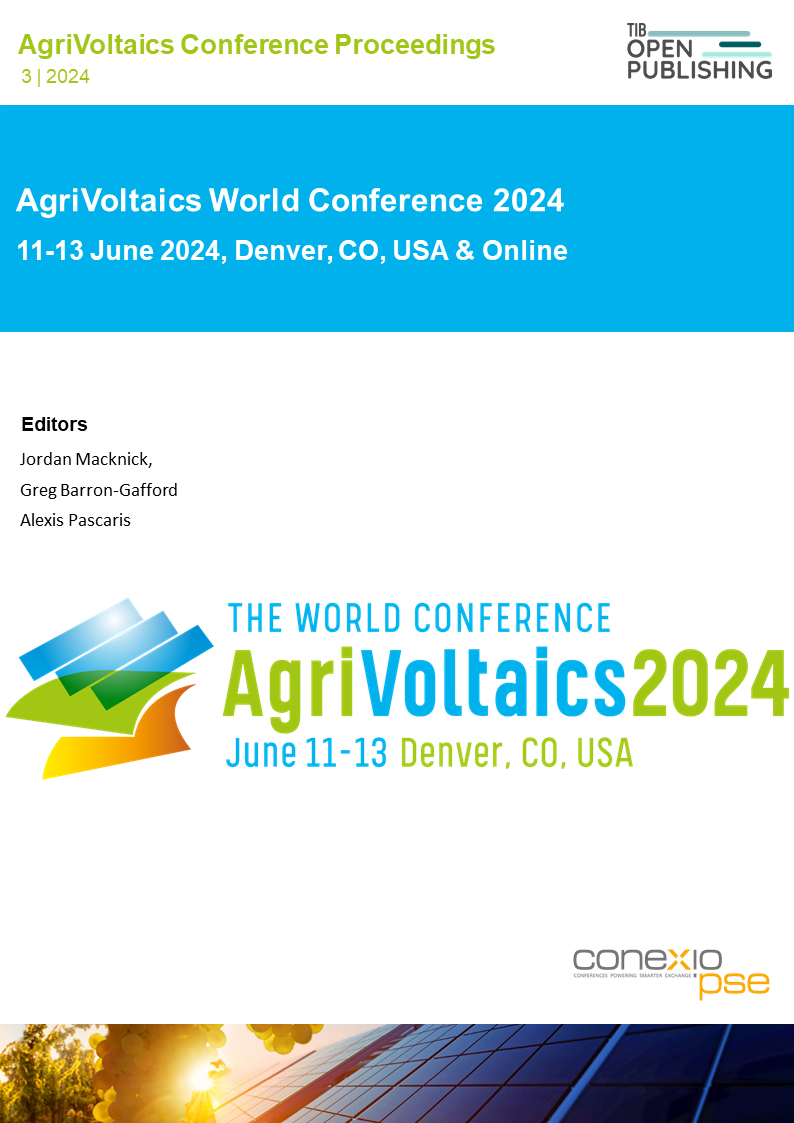A Study of Agrivoltaics Peanut Production With Single-Axis Tracking Systems
DOI:
https://doi.org/10.52825/agripv.v3i.1356Keywords:
Sustainability, Dual-Use, Photovoltaic EfficiencyAbstract
This study investigates the application of single-axis solar tracking systems in peanut production, a crucial crop for global food security and economic sustainability. The experiment was conducted at the FIT Solar Laboratory in Sorocaba, Brazil, from May to September 2023. Peanut plants were cultivated under two conditions: an Agrivoltaic system with bifacial solar modules with a single axis tracking system, and in a conventional agricultural setup. Key findings indicate that peanut biomass yield under Agrivoltaic systems was 17.02% lower than in traditional agricultural systems, primarily due to shading effects inherent to the dual-use configuration. Despite this reduction, the morpho-physiological parameters of peanut plants, including plant height (31.2 ± 1.5 cm), stem diameter (5.3 ± 0.3 mm), stomatal conductivity (0.24 ± 0.02 mol/m²·s), and chlorophyll index (34.6 ± 2.1 SPAD units), remained stable under the Agrivoltaic system, demonstrating the adaptability of peanut plants to lower light conditions. Photosynthetically active radiation (PAR) measurements varied significantly depending on the position under the trackers, with values ranging from 150 to 1,200 µmol/m²·s, reflecting the heterogeneity of light distribution. The Agrivoltaic system achieved an energy production of 2,354.82 kWh/kWp, reflecting a minimal deviation of 4.36% compared to the PV-only control system, which recorded 2,462.26 kWh/kWp. The Energy Performance Index (EPI) for the Agrivoltaic system was calculated at 0.96, demonstrating its efficiency in converting available solar energy under real-world conditions. This performance aligns with industry standards, underscoring the efficiency of single axis tracking systems in balancing agricultural and energy outputs.
Downloads
References
G. W. Crabtree; N. S. Lewis. “Solar energy conversion,” in Physics Today, 2007, vol.60, no.3, pp.37-42, doi: https://doi.org/10.1063/1.2718755
A. O. M. Maka; J. M. Alabid. “Solar energy technology and its roles in sustainable development,” in Clean Energy, 2022, vol.6, no.3, pp. 476-483, doi: https://doi.org/10.1093/ce/zkac023
C. Campillo; R. Fortes; M. H. Prieto. “Solar Radiation Effect on Crop Production,” in Solar Radiation. InTech, 2012, doi: http://dx.doi.org/10.5772/34796
A. C. Noertjahyani; A. Komariah, H. Mulyana. “Shade effect on growth, yield, and shade tolerance of three peanut cultivars,” in Journal Agro, 2020, vol.7, no.1, pp. 102-111, doi: https://doi.org/10.15575/6273
R. E. Blankenship, et al. “Comparing photosynthetic and photovoltaic efficiencies and recognizing the potential for improvement,” in Science, 2011, vol.332, no.6031, pp. 805-809, doi: https://doi.org/10.1126/science.1200165
S. Nonhebel, “Renewable energy and food supply: Will there be enough land?,” in Renewable Energy, 2005, vol.30, no.13, pp. 2283-2301, doi: https://doi.org/10.1016/j.rser.2004.02.003
M. Wagner, et al. “Agrivoltaics: The Environmental Impacts of Combining Food Crop Cultivation and Solar Energy Generation,” in Agronomy, 2023, vol.13, no.2, doi: https://doi.org/10.3390/agronomy13020299
S. Schindele et al. “Implementation of agrophotovoltaics: Techno-economic analysis of the price-performance ratio and its policy implications,” in Applied Energy, 2020, vol.265, doi: https://doi.org/10.1016/j.apenergy.2020.114737
A. Weselek, et al. “Agrophotovoltaic systems: applications, challenges, and opportunities. A review,” in Agronomy for Sustainable Development, 2019, vol.39, no. 35, doi: https://doi.org/10.1007/s13593-019-0581-3
S. N. Bhandari, et al. “Economic Feasibility of Agrivoltaic Systems in Food-Energy Nexus Context: Modelling and a Case Study in Niger,” Agronomy, 2021, vol.11, no.10, doi: https://doi.org/10.3390/agronomy11101906
G. Dinesh; J. M. Pearce. “The potential of Agrivoltaic systems. Renewable and Sustainable,” in Energy Reviews, 2016, vol.54, pp. 299-308, doi: https://doi.org/10.1016/j.rser.2015.10.024
A. Anshul, et al. “Review on Sun Tracking Technology in Solar PV System,” in Energy Reports, 2020, vol.6, pp. 392-405, doi: https://doi.org/10.1016/j.egyr.2020.02.004
H. Mousazadeh, et al. “A review of principle and sun-tracking methods for maximizing solar systems output,” in Renewable and Sustainable Energy Reviews, 2009, vol.13, no.8, pp. 1800-1818, doi: https://doi.org/10.1016/j.rser.2009.01.022
W. Shenying, et al. “Integration of Agricultural Machinery and Agronomy for Mechanised Peanut Production Using the Vine for Animal Feed,” in Biosystems Engineering, 2022, pp. 135-152, doi: https://doi.org/10.1016/j.biosystemseng.2022.04.011
Food and Agriculture Organization of the United Nations (FAO). “Crops and livestock products,” 2024, https://www.fao.org/faostat/en/#data/QCL (February 20th, 2025)
World Population Review. “Peanut Production by Country 2024,” https://worldpopulationreview.com/country-rankings/peanut-production-by-country (February 20th, 2025)
Atlas Big. “World Peanut Production by Country,” https://www.atlasbig.com/en-us/countries-peanut-production (February 20th, 2025)
C. S. Henderson, et al. “Productivity in the peanut under salt stress in soil with a cover of plant mulch,” in Revista Ciência Agronômica, 2023, vol.54, https://doi.org/10.5935/1806-6690.20230043
R. A. M, Bruno, et al. “Advancements in peanut mechanization: Implications for sustainable agriculture,” in Agricultural Systems, 2024, vol.215, doi: https://doi.org/10.1016/j.agsy.2024.103868
L. S. Gerald. “Response of Peanut (Arachis hypogea L.) to Cultivation Methods and Boron and Calcium Application,” in International Journal of Biosciences, 2024, vol.25, no.1, pp. 75-92, doi: http://dx.doi.org/10.12692/ijb/25.1.75-92
G. Yohannes: L. Huaiyong. “Optimizing Peanut (Arachis hypogaea L.) Production: Genetic Insights, Climate Adaptation, and Efficient Management Practices: Systematic Review,” in Plants, 2024, vol.13, no.21, doi: https://doi.org/10.3390/plants13212988
D. Jianshu, et al. “Irrigation and Fertilization Scheduling for Peanut Cultivation under Mulched Drip Irrigation in a Desert–Oasis Area,” in Plants, 2024, vol.13, no.1, doi: https://doi.org/10.3390/plants13010144
N. Puppala, et al. “Sustaining yield and nutritional quality of peanuts in harsh environments: Physiological and molecular basis of drought and heat stress tolerance,” in Frontiers in Genetics, 2023, vol.14, doi: https://doi.org/10.3389/fgene.2023.1121462
S. Asa’a, et al. “A multidisciplinary view on agrivoltaics: Future of energy and agriculture,” in Renewable and Sustainable Energy Reviews, 2024, vol.200, doi: https://doi.org/10.1016/j.rser.2024.114515
M. Junko. “Japan Next-Generation Farmers Cultivate Crops and Solar Energy”, 2013, https://www.renewableenergyworld.com/solar/japan-next-generation-farmers-cultivate-agriculture-and-solar-energy/#gref (February 20th, 2025)
L. Jiufu, et al. “The Early Effects of an Agrivoltaic System within a Different Crop Cultivation on Soil Quality in Dry–Hot Valley Eco-Fragile Areas,” in Agronomy., 2024, vol.14, no.3, doi: https://doi.org/10.3390/agronomy14030584
Z. Fangxin, et al. “Large-scale and cost-efficient agrivoltaics system by spectral separation,” in iScience. 2023, vol.26, doi: https://doi.org/10.1016/j.isci.2023.108129
F. S. N. Augusto. et al. “Influência do sombreamento sobre o crescimento do amendoim,” in XI Jornada de ensino, pesquisa e extensão, 2011, https://www.alice.cnptia.embrapa.br/alice/bitstream/doc/907494/1/InfluenciadosombreamentosobreocrescimentodoamendoimJEPEX2011.pdf (February 20th, 2025)
S. B. Adjahossou, et al. “Ecophysiological responses of peanut (Arachis hypogea) to shading due to maize (Zea mays) in intercropping systems,” in Cameroon Journal of Experimental Biology, 2008, vol.04, no.01, pp. 29-38, doi: https://doi.org/10.4314/cajeb.v4i1.37972
Published
How to Cite
Conference Proceedings Volume
Section
License
Copyright (c) 2025 Milena Chanes de Souza, Ricardo Nery de Castro, Benhur Azambuja Possato, Matthias B. Krause, Sol Hutson

This work is licensed under a Creative Commons Attribution 4.0 International License.
Accepted 2025-01-31
Published 2025-07-18
